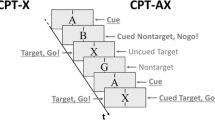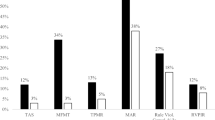Abstract
Continuous Performance Test (CPT) responding was compared between 15 adults with a history (childhood/adolescent) of Conduct Disorder (CD) and 15 normal controls. Of particular interest was whether response latencies and commission errors, which have been suggested to be measures of impulsivity, would differ between the groups. The CPT procedure used included two conditions: Immediate Memory Task and Delayed Memory Task (IMT/DMT; Dougherty et al., 1998). Both the IMT (0.5-s delay) and DMT (3.5-s delay with distracter stimuli at 0.5-s intervals) required the subject to respond if a briefly displayed number was identical to the one presented before it. Stimuli included target (identical match), catch (four of five digits matched), and novel (no match). Participants completed six 22-min testing sessions scheduled across a single day. The most significant findings were that the CD group (compared to the control group) had (a) elevated commission errors (responses to catch stimuli); (b) lower stimulus discriminability (between target and catch stimuli); and (c) shorter response latencies. These results are consistent with the few previous studies indicating that these parameters are related to impulsive behaviors.
Similar content being viewed by others
References
ANSLIE, G. (1975). Specious reward: A behavioral theory of impulsiveness and impulse control. Psychological Bulletin, 82(4), 463–496.
BARRALT, E. S. (1965). Factor analysis of some psychometric measures of impulsiveness and anxiety. Psychological Reports, 16, 547–554.
BARRATI, E. S. (1985). Impulsiveness subtraits: Arousal and information processing. In J. T. Spence & C. E. Izard (Eds.), Motivation, Emotion, and Personality (pp. 137–146). North-Holland, NY: Elsevier Science Publishers B.V.
BAUER, L. O. (1997). Frontal P300 decrements, childhood conduct disorder, family history, and the prediction of relapse among abstinent cocaine abusers. Drug and Alcohol Dependence, 44, 1–10.
BECK, A. T., BROWN, G., EPSTEIN, N., & STEER, R. S. (1988). An inventory for measuring clinical anxiety: Psychometric properties. Journal of Consulting and Clinical Psychology, 56, 893–897.
BECK, A. T., RUSH, A. J., SHAW, B. F., & EMERY, G. (1979). Cognitive theory of depression. New York: The Guilford Press.
BRANCHEY, M. H., BUYDENS-BRANCHEY, L., & HORVATH, T. B. (1993). Event related potentials in substance abusing individuals after long term abstinence. American Journal of Addiction, 2, 141–148.
CORNBLATI, B. A., & KEILP, J. G. (1994). Impaired attention, genetics, and the pathophysiology of schizophrenia. Schizphrenia Bulletin, 20, 31–46.
CURTISS, G., & TUTTLE, K. (1993). Wisconsin card sorting test: Computer version 2 [Program Manual]. Odessa, FL: Psychological Assessment Resources, Inc.
DOUGHERTY, D. M., MOELLER, F. G., STEINBERG, J. L., MARSH, D. M., HINES, S. E., & BJORK, J. M. (1999). Alcohol increases commission error rates for a continuous performance test. Alcoholism: Clinical and Experimental Research, 23(8), 1342–1351.
DOUGHERTY, D. M., STEINBERG, J., WASSEF, A. A., MEDEARIS, D., CHEREK, D. R., & MOELLER, F. G. (1998). Immediate versus delayed visual memory task performance among schizophrenic patients and normal controls. Psychiatry Research, 79, 255–265.
DYKMAN, R. A., ACKERMAN, P. T., & OGLESBY, D. M. (1979). Selective and sustained attention in hyperactive, learning-disabled and normal boys. Journal of NeNous and Mental Disease, 167, 288–297.
ERLENMEYER-KIMLING, L., & CORNBLATT, B. (1987). High-risk research in schizophrenia: A summary of what has been learned. Journal of Psychiatric Research, 21, 401–411.
FIRST, M. B., SPITZER, R. L., GIBBON, M., & WILLIAMS, J. B. W. (1996). Structured Clinical Interview for Dsm-Iv Axis I Disorders: Non-patient Edition (Scid-Np). Biometrics Research Department, New York State Psychiatric Institute, Ny.
GESCHEIDER, G. A. (1985). Psychophysics: Method, theory, and application (p. 97). Hillsdale, NJ: Lawrence Erlbaum.
GORENSTEIN, E. E., & NEWMAN, J. P. (1980). Disinhibitory psychopathology: A new perspective and a model for research. Psychological Review, 87, 301–315.
GREEN, L., & RACHLIN, H. (1996). Commitment using punishment. Journal of the Experimental Analysis of Behavior, 65(3): 593–601.
HALPERIN, J. M., WOLF, L., GREENBLATT, E. R., & YOUNG, G. (1991). Subtype analysis of commission errors on the continuous performance test in children. Developmental Neuropsychology, 7, 207–217.
HALPERIN, J. M., WOLF, L. E., PASCUALVACA, D. M., NEWCORN, J. H., HEALEY, J. M., O'BRIEN, J. D., MORGANSTEIN, A., & YOUNG, J. G. (1988). Differential assessment of attention and impulsivity in children. Journal of American Academy of Child and Adolescent Psychiatry, 27, 326–329.
HEATON, R. K., CURTISS, G., TUTTLE, K., & PAR Staff (1993). Wisconsin Card Sorting Test: Computer (Version 2) [Computer Software]. Odessa, FI: Psychological Assessment Resources, Inc
KOCH, M., & MORGUET, M. (1985). Investigation in the use of a vigilance test in psychomedical assessment. Blutalkohol, 22, 391–396.
LOEBER, R. (1990). Development and risk factors of juvenile antisocial behavior and delinquency. Clinical Psychology Review, 10, 1–41.
MILLER, R. C. (1984). The effect of low doses of alcohol on human behavior. Unpublished doctoral thesis, University of Texas at Austin.
NUECHTERLEIN, K. H., & DAWSON, M. E. (1984). Information proceSsing and attentional functioning in the developmental course of schizophrenic disorders. Schizophrenia Bulletin, 10, 160–203.
OLLMAN, R. (1966). Fast guess in choice reaction time. Psychonomic Sciences, 6, 155–156.
O'DOUGHERTY, M., NUECHTERLEIN, K. H., & DREW, B. (1984). Hyperactive and hypoxic children: Signal detection, sustained attention, and behavior. Journal of Abnormal Psychology, 93, 178–191.
PATTON, J. M., STANFORD, M. S., & BARRATT, E. S. (1995). Factor structure of the Barratt Impulsiveness Scale. Journal of Clinical Psychology, 51, 768–774.
QUAY, H. C. (1988). The behavioral reward and inhibition system in childhood behavior disorder. In L. M. Bloomingdale (Ed.), Attention Deficit Disorder (Vol. 3, pp. 176–186). New York: Spectrum.
RACHLIN, H., RAINERI, A., & CROSS, D. (1991). Subjective probability and delay. Journal of the Experimental Analysis of Behavior, 55(2), 233–244.
ROBERTS, L. E., RAU, H., LULZENBERGER, W., & BIRBAUMER, N. (1994). Mapping P300 waves onto inhibition: Go/No-Go discrimination. Electroencephalography and Clinical Neurophysiology, 92, 44–55.
ROSVOLD, H. E., MIRSKY, A., SARASON, I., BRANSOME, E. D., Jr., & BECK, L. H. (1956). A continuous performance test of brain damage. Journal of Consulting Psychology, 20, 343–350.
SCHACHAR, R. J., TANNOCK, R., & LOGAN, G. (1993). Inhibitory control, impulsiveness, and attention deficit hyperactivity disorder. Clinical Psychology Review, 13, 721–739.
SERGEANT, J. A., & SHOLTON, C. A. (1985). On resources strategy limitations in hyperactivity: Cognitive impulsivity reconsidered. Journal of Child Psychology and Psychiatry, 25, 809–819.
SOSTEK, A. J., BUCHSBAUM, M. S., & RAPOPORT, J. L. (1980). Effects of amphetamine on vigilance performance in normal and hyperactive children. Journal of Abnormal Child Psychology, 8, 491–500.
SPERLING, G. (1984). A unified theory of attention and Signal detection. In R. Parasuraman & D. R. Davies (Eds.), Varieties of attention (pp. 103–181). New York: Academic.
SPLLZER, R. L., WILLIAMS, J. B. W., GIBBON, M., & FIRST, M. B. (1990). Structured clinical interview for Dsm-Iii-R — personality disorders (Scid-Ii, Version 1.0). Washington, DC: American Psychiatric Press.
SWANSON, L. (1981). Vigilance deficit in learning disabled children: A signal detection analysis. Journal of Child Psychology and Psychiatry, 22, 393–399.
SYKES, D. H., DOUGLAS, V. I., & MORGENSTERN, G. (1973). Sustained attention in hyperactive children. Journal of Child Psychology and Psychiatry, 14, 213–220.
SYKES, D. H., DOUGLAS, V. I., WEISS, G., & MINDE, K. K. (1971). Attention in hyperactive children and the effect of methylphenidate (Ritalin). Journal of Child Psychology and Psychiatry, 12, 129–139.
WINDLE, M., & WINDLE, R. C. (1993). The continuity of behavioral expression among disinhibited and inhibited childhood subtypes. Clinical Psychology Review, 13, 741–761.
WOHLBERG, G. W., & KORNETSKY, C. (1973). Sustained attention in remitted schizophrenics. Archives of General Psychiatry, 28, 533–537.
YELLOT, J. I. (1971). Corrections for fast guessing and speed-accuracy-tradeoff in choice reaction time. Journal of Mathematical Psychology, 8, 159–199.
Author information
Authors and Affiliations
Corresponding author
Additional information
This research was supported by grants from the National Institute on Alcoholism and Alcohol Abuse (AA-10095 & AA-10828) and the National Institute on Drug Abuse (DA- 08425).
Rights and permissions
About this article
Cite this article
Dougherty, D.M., Bjork, J.M., Marsh, D.M. et al. A Comparison Between Adults With Conduct Disorder And Normal Controls on a Continuous Performance Test: Differences in Impulsive Response Characteristics. Psychol Rec 50, 203–219 (2000). https://doi.org/10.1007/BF03395352
Published:
Issue Date:
DOI: https://doi.org/10.1007/BF03395352




